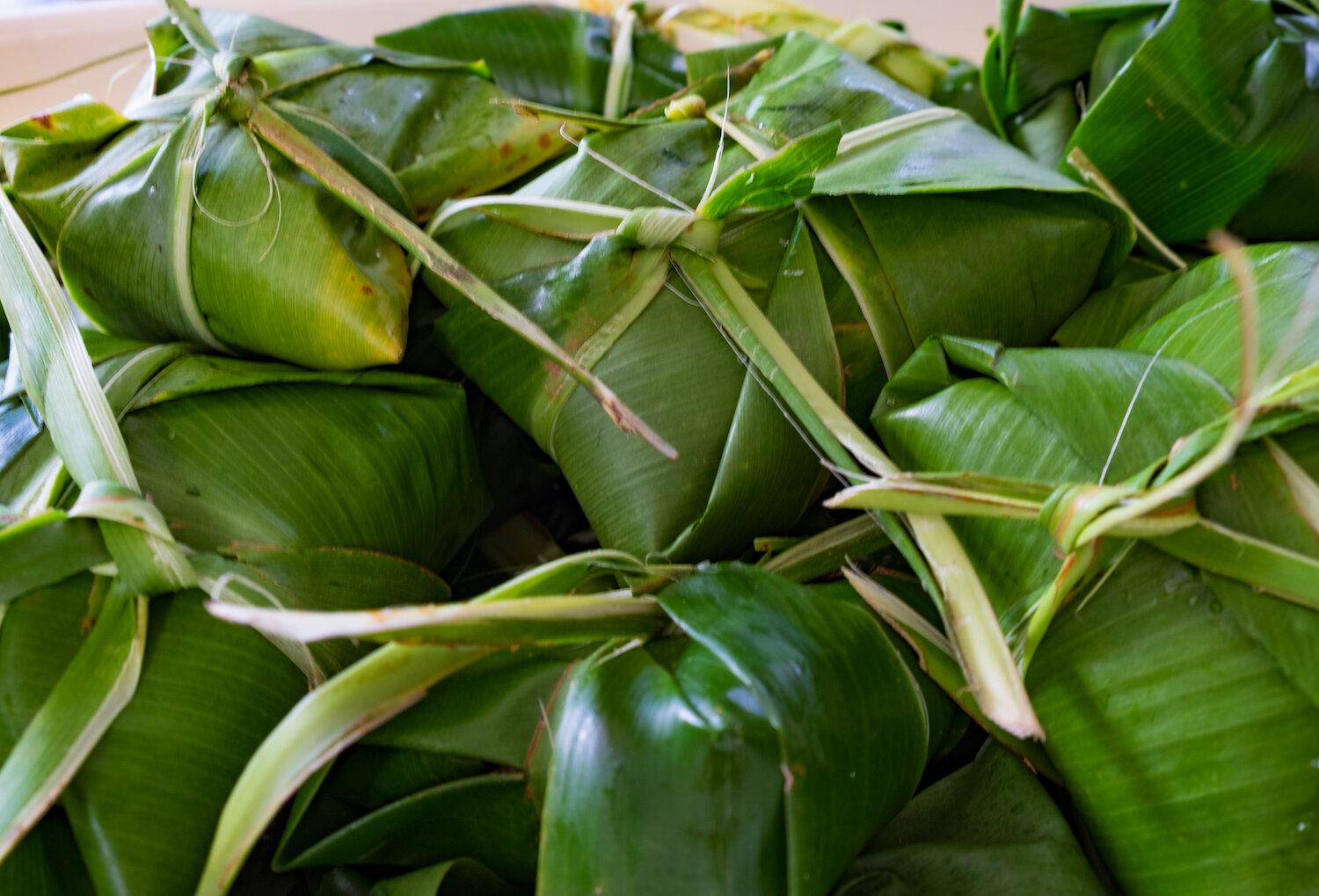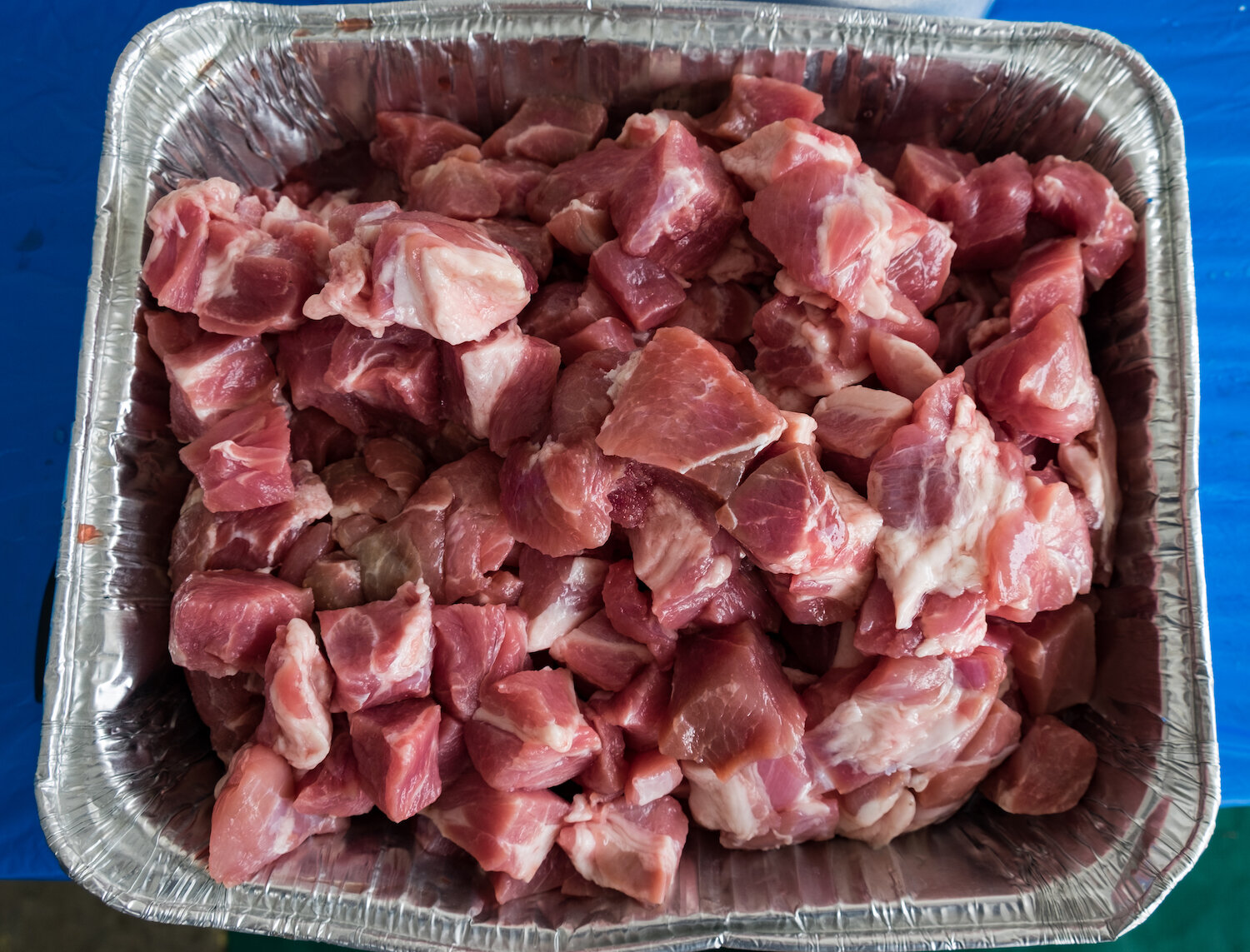I'll never forget my first lau lau party.
I met one of the hosts at a yoga retreat during my first year on Oʻahu.
I think the fact that food dominated most of our conversations gave her the indication that I would be a good candidate for her lau lau assembly line.
In the weeks leading up to the event we were asked to bring ti leaves, pork or fish, and a breakfast item or side dish to contribute. Guests were also encouraged to bring an alcoholic beverage of their choice.
The ingredients that go into the preparation of lau lau are very specific and somewhat time consuming, so our host asked us to prep ahead.
Ti leaves
First, you have to have ti leaves. But not just any ti leaves, they can’t be too small and they can’t be too big either. You can forage for them in people’s backyards or while hiking, or buy them at flower shops that make leis.
These leaves are for wrapping the lau lau, as a vessel to steam them in, they are not edible.
First, clean the ti leaves.
They also have to be “de-boned.” You do this by placing the leaf, shiny side down, on a table and making a little nick where the stem first starts to protrude at the top of the leaf. Then you pick up the leaf placing your forefinger behind the leaf, where the back of the stem is, and your thumb in front of the leaf to secure the leaf in place. Then with your other hand you gently peel back the top of the leaf which pops the stem out.
You continue with this motion all the way down, until you have stripped the entire stem from the leaf, but have left the leaf completely still intact. When you reach the bottom of the stem, split the stem in two, all the way up to the base of the leaf.
Here’s how…..
Taro leaves (luau leaves)
These can be bought at Wongs in 20 lb bags for around $38, at Foodland, and at the Farmers Market––MA’O Organic Farms will sometimes have them in Kaka’ako on Saturdays.
Using scissors, snip off the stems and cut the stems into one inch pieces. You will end up with a giant pile of leaves and a large bowl of cut up stems. Wash and dry them well. A group of 6 or 8 of us did this at the party before we started wrapping lau lau. An important note about taro leaves, they must be cooked before eaten. That is unless, you like the sensation of eating broken glass.
Next, remove taro stems with scissors and cut them into 1 inch pieces.
Next, wash and dry the taro leaves and stems.
Pork shoulder
Purchase boneless pork shoulder. Do not remove or discard any fat. The more fat the better in this dish. It is what keeps the lau lau nice and moist and adds flavor. Dice it into one inch cubes.
Next, dice the pork shoulder
Fish
Select fish that has a high oil content. Like the pork, the fattiness of the fish is what makes the lau lau rich and succulent. Although neither local, salmon or black cod (which is actually sable fish, but often called butterfish in Hawaiʻi) are commonly used. We used both.
The salmon needs to be scaled, but you can leave the skin on and the bones in, since they are both delicate and will melt away in the cooking process.
For the black cod, remove the skin and bones.
Once your fish has been cleaned, dice it into 1 inch pieces.
Next, dice the fish.
Salt
Use a course Hawaiian sea salt such as Alaea salt.
I was told that “you cannot use too much salt” in this dish, so have more than you think you will need on hand.
Kiawe wood
Kiawe is a type of mesquite. You can find it by foraging around the island or buy it from a local firewood business like Kiawe Hawaii. It lends a nice flavor and aroma to the lau lau when steaming it over an open fire.
kiawe wood
Equipment
You will need long prep tables, scissors, large steamer pots, cinder blocks, heavy heat-proof gloves and a refrigerator full of beer (to keep you entertained while the lau lau cooks). Tables and industrial sized pots can be purchased at a restaurant supply store such as Chef Zone.
Use a stock pot with steamer insert
Or, other heavy bottom pot with steamer insert
People started trickling into our host’s home around 8:00 a.m. Coffee was offered, name tags were made, the breakfast buffet started coming together, and mimosas were poured.
Around 9:00 a.m. the co-host's husband – who they call the Lau Lau Luna (luna was what supervisors were called in the sugarcane fields back in the plantation era) – told us the story of how he started this annual tradition over twenty years ago. Afterward he made a toast to honor the loved ones that were no longer with us.
After diving into a spread of fresh fruit harvested from the backyard, home-made pastries, banana bread, frittatas and quiches, we filed out into the garage to start wrapping lau lau.
The table of ingredients was set up assembly line style, but the process in which we prepared each lau lau was not. Each person was responsible for seeing their lau lau all the way through beginning to end.
Building lau lau
Start with a pile of taro leaves stacked in one hand. The number of leaves will depend on how big they are. You will want to fan them out and layer them, so that they make a spiral and create a base big enough to enclose a large handful of pork and fish.
First, stack several taro leaves in one hand
Next you go down the line, adding first about 4 or 5 pieces of pork (again, depending on the size), 1-2 pieces of fish, a small handful of taro stems, and a liberal sprinkling of sea salt.
Add pork
... fish, taro stems and salt.
Finally, wrap the whole bundle in ti leaves. You will need two leaves for this. Apparently, there are a couple of different ways you can do this, but here is how we wrapped ours….
Wrap and tie the bundle in two ti leaves. Tie with stems from the first ti leaf.
First, lay one ti leaf on the table and place your bundle at the very top. Roll the bundle up in the leaf until you get almost to the bottom and stop. Lay a second ti leaf on the table, place the bundle on top turning it, so that the open ends are facing the length of the second ti leaf, roll it up until you get almost to the bottom of the leaf and stop. Take the split stems from the first leaf that are now sticking out, and tie a double knot around the pouch.
Secure it again, by then tying it with the split stems from the second leaf.
A demo from the Lau Lau Luna…
While the majority of the party is in the garage wrapping lau lau, two fires were being built in the yard to create two make-shift wood burning stoves made out of cinder blocks and grill grates.
When the lau lau were ready, we brought them out to the yard in large coolers and laundry baskets.
Lau Lau Luna and his sous chef, Luna Jr. were in charge of the cooking process.
Junior carefully stacked each lau lau tightly into two industrial sized pots with steamer baskets counting each one as he went. The pots needed to come to a full boil before the lau lau could be added. Once in, the pots were covered with lids and then weighed down with cinder blocks to keep steam from escaping. A timer was then set for exactly 3 ½ hours.
Now that the lau lau was on, and most of the work was complete we had time to hang out, talk story, and drink beer.
As the day went on, more side dishes were delivered and prepared. By the time the 3 ½ hours was up we had ourselves a proper luau buffet, complete with chicken long rice, poke, potato-mac salad, poi, fried rice, and musubi, along with some other tasty non-traditional salads and a couple of desserts.
It almost brought tears to my eyes when Lau Lau Luna offered me one of the first lau lau to come out of the pot. I grabbed a pair of chopsticks and dove in, tasting the first bite unadulterated before adding a splash of chile pepper water on top. It was heavenly. The taro leaves cooked down and had a reminiscent flavor and texture of canned spinach that reminded me of my childhood. The fatty pork and fish were tender, juicy and unctuous, and the chile pepper water cut the fattiness of both to completely balance the whole thing out.
From left to right – Chinese long rice, poi, potato-mac salad, marlin poke, coleslaw, and lau lau.
At the end of the party styrofoam boxes were passed out and guests loaded them up with the fruits of their labor. Photos were posted on Instagram and high fives, kisses on the cheek, and hugs were given all around.
I was honored to be invited to this event, get to enjoy this feast, and be appreciated for my efforts. It was an experience of true aloha that I will always cherish.
Mahalo nui loa to everyone that was involved.
Especially our hosts, Lau Lau Luna and Luna lady…

































